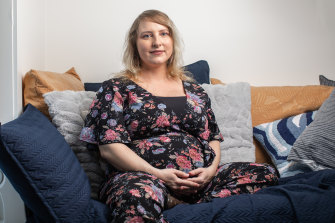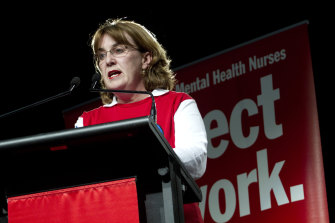Key points
- Expectant mothers are facing repeated delays to planned caesareans or birth inductions, as overrun maternity wards battle diminishing staffing levels on top of a surge in women delivering babies while they are infected with COVID-19.
- Doctors estimate there has been a 20 to 25 per cent increase in the number of expectant mothers testing positive for COVID-19 when they arrive at hospitals to give birth, while maternity wards are now grappling with midwife shortages of up to 30 per cent on any given day.
- Women infected with the latest Omicron subvariant do not generally require hospitalisation due to high vaccination rates.
Expectant mothers are facing repeated delays to planned caesareans and birth inductions as oversubscribed maternity wards battle diminishing staffing levels and a surge in COVID-positive women giving birth.
Obstetrician Nisha Khot, who works at two major Melbourne hospitals, says the whole system has been under strain during the pandemic, but demand in maternity wards has ramped up again in recent months.
Ella Chorazy is about to have her first baby. Credit:Scott McNaughton
Khot estimates there has been a 20 to 25 per cent increase in the number of expectant mothers testing positive for COVID-19 when they arrive at hospitals to give birth. Maternity wards are also grappling with midwife shortages of up to 30 per cent on any given day and rising numbers of staff are being infected with respiratory illnesses.
“We are struggling with staffing the wards,” Khot said. “We have midwives and doctors who are off sick because of COVID-19 or because of all the other viruses that are going around.
“The other side, of course, is that women are still having babies and women are getting sick and if they get sick that they’re in hospital for longer.”
Ella Chorazy is due to give birth to her first child at the Royal Women’s Hospital in early August, just as the peak of the latest coronavirus wave is forecast to crash over the healthcare system.
The 35-year-old university academic said while she cannot wait to hold her baby for the first time, the last few weeks of her pregnancy have been tinged with apprehension.
At the beginning of the pandemic, Chorazy said she would have been most worried about being infected with coronavirus. Now, she is triple vaccinated, but concerned about hospital staffing shortages.
“I have been quite calm throughout the pregnancy, but now am a little bit anxious and thinking things like ‘what if I go into labour, and there’s not enough staff? What is something goes wrong?’” she said.
“I am the sort of person that inherently trusts our hospital system to be able to provide for me if I’m in need and I have so much empathy for the healthcare workers are facing.
“But I also rationally know that they are experiencing huge staffing shortages as a result of pressures associated with COVID so the anxiety of something going wrong is in the back of my mind.”
Khot said women who were infected with the latest Omicron subvariant did not generally require hospitalisation due to the virus and appeared to be showing milder symptoms.
“Although there has been an uptick in the number of cases, the cases have been relatively mild. The vaccination rates are quite high, which also is helping.”
Stefan Kane, medical director of maternity services at the Royal Women’s Hospital and a maternal-fetal medicine subspecialist obstetrician, said the silver lining in the latest Omicron wave was that pregnant women infected with coronavirus were largely triple vaccinated or had even had their fourth dose and were less likely to become critically ill.
Medical director maternity services at the Royal Women’s Hospital Stefan Kane said the silver lining in the latest Omicron wave was pregnant women infected with coronavirus were largely triple vaccinated and far less inclined to become critically ill.Credit:Chris Hopkins
Last year’s Delta outbreak caused a surge in largely unvaccinated pregnant women and new mothers being admitted to intensive care, critically ill with coronavirus.
“Unlike earlier waves of the pandemic, we aren’t seeing as many very unwell women and I think that’s a combination both of the impact of vaccination, and also possibly the different ways in which the new variants affect people,” Kane said.
But with more than 10,000 new coronavirus infections being reported each day in Victoria, and thousands of other cases going undetected, staffing shortages mean nurses and midwives are frequently working double shifts, hours of overtime and coming in on their days off.
“It’s so important to acknowledge just how hard they are working in very, very difficult circumstances and how dedicated they are to the care of pregnant women,” Kane said.
John Regan, the vice president of the Royal Australian and New Zealand College of Obstetricians and Gynaecologists, who is also the head of obstetrics at Monash Medical Centre in Clayton, said the ward was facing crippling staff shortages, estimating it was typically about 20 per cent.
There are three rooms designated for COVID-19 positive mothers at Monash, which had become a streaming site for mothers sick with COVID-19 who are experiencing acute respiratory issues and need intensive care.
A lack of available midwives and doctors meant planned caesareans or birth inductions are being rescheduled up to four times, and for up to three days in some cases, Khot said.
Births are often induced when mothers have blood pressure issues, gestational diabetes or have gone well past their due date.
”If you delay a scheduled C-section, a woman might go into labour and you have to do the C-section in the middle of the night with fewer staff because you have no other option.”
Australian Nursing and Midwifery Federation Victorian secretary Lisa Fitzpatrick.Credit:Luis Ascui
Victorian secretary of the Australian Nursing and Midwifery Federation Lisa Fitzpatrick warned recommended midwife-to-patient ratios in postnatal care wards were still only being met about 60 per cent of the time.
Fitzpatrick said midwives were repeatedly doing double shifts as hospitals struggled to fill gaps, mostly due to respiratory illnesses. Hospitals were also relying heavily on final-year midwifery students or registered nurses finishing up their postgraduate studies in midwifery.
“They are [maternity hospitals and midwives] desperately trying to ensure that they don’t adjust any sort of visitor rules,” Fitzpatrick said.
“But that comes with a lot of additional work for the nurses and midwives.”
All hospital visitors must be fully vaccinated or show evidence of a negative result from a rapid antigen test taken on the day of the visit.
A Victorian government spokeswoman said: “Despite the global midwife shortage, staff absences due to COVID or the flu and record demand on our health system, our midwives and nurses continue to deliver the best possible care to the community.”
“We’re investing nearly $10 million to support, train and place undergraduate midwives in our hospitals providing much-needed support on the ground,” she said. The government was also building capacity in midwifery and nursing, she said.
Stay across the most crucial developments related to the pandemic with the Coronavirus Update. Sign up for the weekly newsletter.
Most Viewed in National
From our partners
Source: Read Full Article


